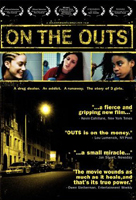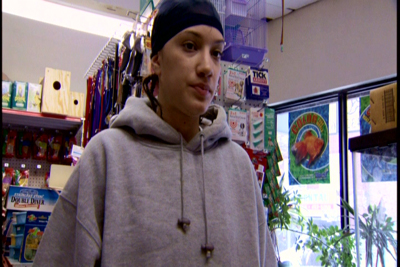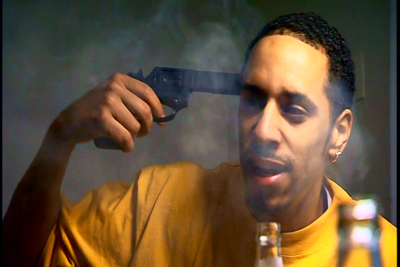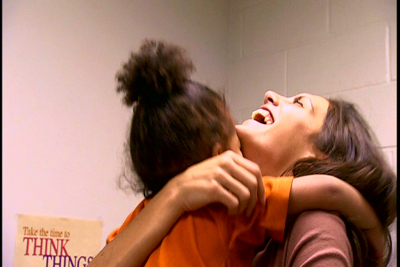 BUY IT AT AMAZON: CLICK HERE!
BUY IT AT AMAZON: CLICK HERE!
STUDIO: Warner Bros. Home Entertainment
MSRP: $19.98
RATED: R
RUNNING TIME: 83 Minutes
SPECIAL FEATURES:
• Feature commentary w/ creators
• "Making-of" featurette
• On Location with Punky Pagan
• Interview w/ Cookie, one of the film’s inspirations
• Rapping with Don Parma
• Trailers
The Pitch
"It’s
Kids
meets Thirteen, and guess what — misery is cumulative!"
The Humans
Judy
Marte (Rasing Victor Vargas), Ann Mariano, Paola Mendoza.
The Nutshell
Based on
the real-life experiences of girls in social care, On the Outs is about three
girls from Jersey City whose disparate lives are unified by the common thread of
drug abuse. Suzette hooks up with a new guy who gets her pregnant and leaves
her holding the bag, both figuratively and literally; Marisol tries to tell
everyone that she’s working hard to stay clean and sober, but her words won’t
be enough for her to keep her child; and Oz bounces in and out of juvie on a
recurring cycle of possession with intent to sell. Prisons are the order of the
day, as the girls meet briefly inside the hall, only to be expelled into the
wider jails of their barrios.

I am following my fish.
The Lowdown
On the Outs is a movie that lives or dies on
how effectively it involves the audience. It shares this quality with a number
of documentaries, and other stories in which all your sympathy and interest is
based on the realization that these things are actually happening somewhere in
the world. It’s kind of disingenuous to bill On the Outs as a tragedy
for that very reason; instead, I’d call it a meta-tragedy — it’s certainly a sad
story, when set on its own, but lacks the necessary bitterness when lacking a direct comparison to life beyond the screen.
In that
it mimics a documentary style, that objectiveness of moral position succeeds.
It’s supported by a number of dead-on filmmaking choices, from the decision to
forego a typical soundtrack to the extended takes and faux-observer camera
focus. Unfortunately, the few scenes in which the sure direction of Lori
Silverbush and Michael Skolnik falter are the ones that are the most important
in solidifying a gritty realism. Whenever a sequence of violence takes place
the editing because quick and jumpy, which ruins the effect of the movie being
nothing more than a window into these characters’ world.

Did you know a lobotomy goes in through your ocular cavity?
That’s
something of a nit-picky criticism, but I bring it up because the three
protagonists of On the Outs won my full attention, and it was uncomfortable to
have it jarred. All three young actresses (Marte, Mariano, and Mendoza, the
latter of which also has a creator credit on the film) maintain a fluidity of
character and sell some pretty convincing emotional outbursts. All three
performances are praiseworthy, but I’d like to single out Ms. Mendoza for her
third act series of breakdowns as she learns that she has lost custody of her
toddler.
relieved when the scene cut to her walled off in her sound-dampened cell, her
screams turned down to something less shrill.
I want to
emphasize how well these three young ladies do with their respective roles,
because, at first, On the Outs doesn’t seem to give them much material to work
with. The structure of the screenplay is intriguing, with the three concurrent
stories featuring characters in three separate stages of devolution. Suzette
(Mariano) is the innocent; Oz (Marte) is the drug dealer and frequent inmate;
and Marisol (
of the film, it’s reasonable to fear that the characters will be more
archetypes than individuals. Thankfully, that fear burns away and the screenplay
deftly works the three distinct stories to their potential, packing in so much
content that the film’s brief 83 minutes seems to stretch much further.
While I
admire the convinction and professionalism that these young actresses display,
I have to fault the screenplay for not testing their limits enough. There is
very little emotional range in On the Outs. The primary goals of
each of the characters are bent toward disaster, with the occasional stop along
the way for misery. Some of that is defrayed by their respective family
interactions, but what could have been a note of leavening sweetness goes sour
without exception. Things start bad, they get worse, and the repetitive calls
for a given actress to step up her emotion another notch get lost in the
eventual altitude.

"Now, class, can you guess the derivative of ho in the given figure?"
"Things
fall apart," wouldn’t be a bad thesis for this film, but I think I’m more
tempted to go with: "People make bad decisions." It’s the sort of
grounding concept that has resulted in some truly tragic stories. Othello
comes to mind, or maybe anything that Thomas Hardy touched. The difference
between On the Outs and those bits of literature is that the tragedies
are self-contained, where On the Outs relies on being a part
of the present. People make bad decisions, says the film, but surely you’re
aware of how society limits their available decisions so that all they even
have are the bad ones.
It slips
from being a movie of true impact because of its reliance on meta-tragedy,
instead of nailing its emotional inspiration within the world of the film. Nevertheless,
there are moments of broken-nerve beauty and enough pure talent in the
filmmaking and acting to make this a valuable film, even if it will be dated in
a decade, and plays best to the in-crowd.
The Package
Co-creators
Paola Mendoza, Lori Silverbush, and Michael Skolnik give a thoughtful and
intricate commentary. There’s rarely any dead air, and the creators are all
very quick to point out the influences that other films, music, and experiences
have played on the creation of On the Outs. It’s one of the better
commentary tracks I’ve had the pleasure of hearing.
The
requisite ten-minute "making-of" featurette focuses on the film’s tie
to real life and the experiences of the girls who inspired the stories. More
and more, I’m gettig the feeling that these featurettes are designed like pitch
reels.

It’s not safe to cuddle a vampire baby.
There are
also a couple of brief interviews with folks from the streets. Punky Pagan, who
has a role in the film, takes the camera on a two-minute tour of some of the
locations, with running commentary about how hard life on the street is. The
other segment features a girl named Cookie, who was one of the aforementioned
inspirations for the film. Cookie’s an interesting girl, and it’s neat to hear
her voice for ten minutes. It’s not hard to see why the creators felt the urge
to make this film.
On the
briefer side, actor Don Parma does a little rapping on set. You also get a
trailer for this movie, and a sneak preview for the upcoming documentary Autumn’s
Eyes, which promises to be On the Outs minus fiction, which,
arguably, is how this story ought to have been told in the first place.
7.8 out of 10